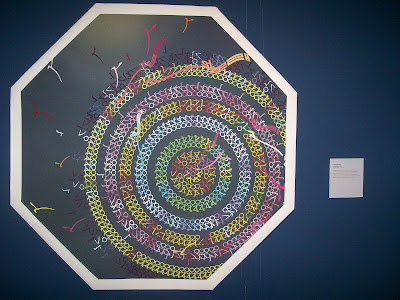
The first thing that comes to mind at the Hangul exhibit is the word "modern." There is this category called modern art which supposedly portrays abstract ideas about the future of society. Interestingly enough, the designs which are seen as "modern," and therefore follow the aesthetic of the future, are actually the leaders into this futuristic world in which design values lines, symmetry, precision, and boldness the most.
The first image seen in the Hangul exhibit is an octogon containing colorful wheels of the Korean language. This image strikes me with its perfect dimensions, but also with its bold, off-centered statement. The perfect lines and flawless circles in this design bring the future to mind; it is a product of the refining and revising that has been put into societies institutions, in an attempt to create a near-perfect world. Medicine is refined into exact measurements and causes, so as to prolong life. Entertainment technology has reached lightspeed, bringing whatever one wants to them immediately, via a cell-phone sized device, no less. Education has been revamped time and time again to produce the highest test scores, the most homogenous minds possible. Society has been cut into little squares, different portions of life; and all of its problems have been fixed or nearly done away with, all due to people following the straight lines, the rules and propaganda telling them that to live this way is better.
At the same time, however, that the lines and dimensions of this piece invoke thoughts of a conflict and passion-free future, the colored circles are bold in their placement to the side. The colors do not make me think of the past, or of the future, but of the here and now, and of everything surrounding it. The bright pinks, greens, yellows, and reds are unplanned emotions, unregulated thoughts. The off-center circles also indicate a breaking of the rules and the symmetry of the perfect future society. This element of passion or rebellion introduces a contrast to the perfect lines surrounding it; representing the always-present human emotions which are natural, quick to manifest, and cannot be tied down.
The perfect dimensions of this Hangul design, when accompanied by its passionate colors and tweaked placement, presents the conflict arising in society's modernization. The lines represent the perfected side of society which creates a homogenous, fair, environment for everyone. In contrast, the colors remind us of the human nature to feel and be passionate in a unique way; our inability to be rigid and uniform after all. Is this what the future is moving towards? A contrast between standard of living and individuality? The Hangul exhibit portrayed many images of this conflict, showing that there is, indeed, a tug-of-war between the regular and the natural.






